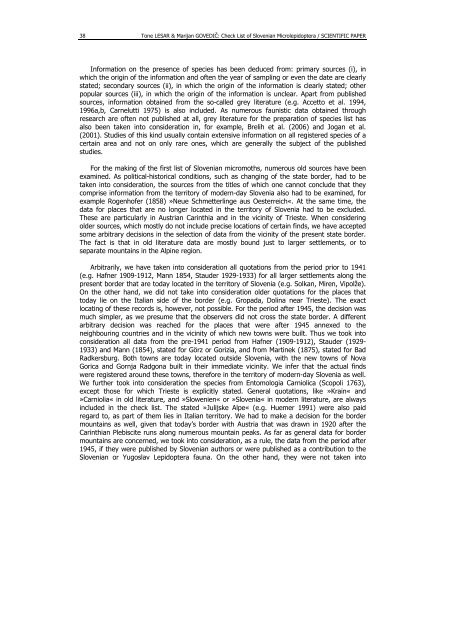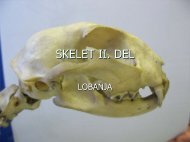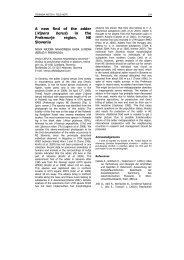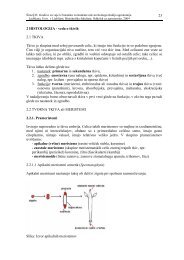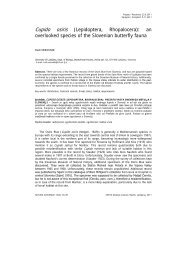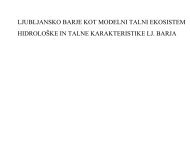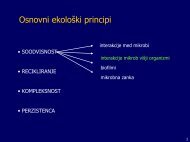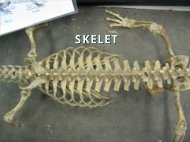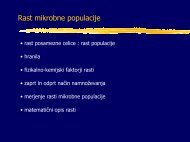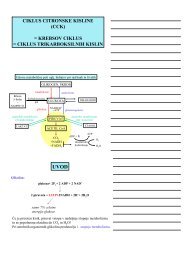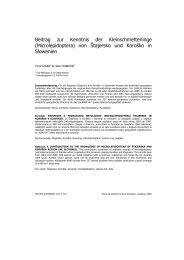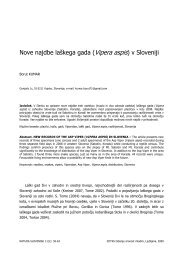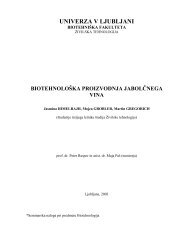Check list of Slovenian Microlepidoptera - Univerza v Ljubljani
Check list of Slovenian Microlepidoptera - Univerza v Ljubljani
Check list of Slovenian Microlepidoptera - Univerza v Ljubljani
Create successful ePaper yourself
Turn your PDF publications into a flip-book with our unique Google optimized e-Paper software.
38<br />
Tone LESAR & Marijan GOVEDIČ: <strong>Check</strong> List <strong>of</strong> <strong>Slovenian</strong> <strong>Microlepidoptera</strong> / SCIENTIFIC PAPER<br />
Information on the presence <strong>of</strong> species has been deduced from: primary sources (i), in<br />
which the origin <strong>of</strong> the information and <strong>of</strong>ten the year <strong>of</strong> sampling or even the date are clearly<br />
stated; secondary sources (ii), in which the origin <strong>of</strong> the information is clearly stated; other<br />
popular sources (iii), in which the origin <strong>of</strong> the information is unclear. Apart from published<br />
sources, information obtained from the so-called grey literature (e.g. Accetto et al. 1994,<br />
1996a,b, Carnelutti 1975) is also included. As numerous faunistic data obtained through<br />
research are <strong>of</strong>ten not published at all, grey literature for the preparation <strong>of</strong> species <strong>list</strong> has<br />
also been taken into consideration in, for example, Brelih et al. (2006) and Jogan et al.<br />
(2001). Studies <strong>of</strong> this kind usually contain extensive information on all registered species <strong>of</strong> a<br />
certain area and not on only rare ones, which are generally the subject <strong>of</strong> the published<br />
studies.<br />
For the making <strong>of</strong> the first <strong>list</strong> <strong>of</strong> <strong>Slovenian</strong> micromoths, numerous old sources have been<br />
examined. As political-historical conditions, such as changing <strong>of</strong> the state border, had to be<br />
taken into consideration, the sources from the titles <strong>of</strong> which one cannot conclude that they<br />
comprise information from the territory <strong>of</strong> modern-day Slovenia also had to be examined, for<br />
example Rogenh<strong>of</strong>er (1858) »Neue Schmetterlinge aus Oesterreich«. At the same time, the<br />
data for places that are no longer located in the territory <strong>of</strong> Slovenia had to be excluded.<br />
These are particularly in Austrian Carinthia and in the vicinity <strong>of</strong> Trieste. When considering<br />
older sources, which mostly do not include precise locations <strong>of</strong> certain finds, we have accepted<br />
some arbitrary decisions in the selection <strong>of</strong> data from the vicinity <strong>of</strong> the present state border.<br />
The fact is that in old literature data are mostly bound just to larger settlements, or to<br />
separate mountains in the Alpine region.<br />
Arbitrarily, we have taken into consideration all quotations from the period prior to 1941<br />
(e.g. Hafner 1909-1912, Mann 1854, Stauder 1929-1933) for all larger settlements along the<br />
present border that are today located in the territory <strong>of</strong> Slovenia (e.g. Solkan, Miren, Vipolže).<br />
On the other hand, we did not take into consideration older quotations for the places that<br />
today lie on the Italian side <strong>of</strong> the border (e.g. Gropada, Dolina near Trieste). The exact<br />
locating <strong>of</strong> these records is, however, not possible. For the period after 1945, the decision was<br />
much simpler, as we presume that the observers did not cross the state border. A different<br />
arbitrary decision was reached for the places that were after 1945 annexed to the<br />
neighbouring countries and in the vicinity <strong>of</strong> which new towns were built. Thus we took into<br />
consideration all data from the pre-1941 period from Hafner (1909-1912), Stauder (1929-<br />
1933) and Mann (1854), stated for Görz or Gorizia, and from Martinek (1875), stated for Bad<br />
Radkersburg. Both towns are today located outside Slovenia, with the new towns <strong>of</strong> Nova<br />
Gorica and Gornja Radgona built in their immediate vicinity. We infer that the actual finds<br />
were registered around these towns, therefore in the territory <strong>of</strong> modern-day Slovenia as well.<br />
We further took into consideration the species from Entomologia Carniolica (Scopoli 1763),<br />
except those for which Trieste is explicitly stated. General quotations, like »Krain« and<br />
»Carniolia« in old literature, and »Slowenien« or »Slovenia« in modern literature, are always<br />
included in the check <strong>list</strong>. The stated »Julijske Alpe« (e.g. Huemer 1991) were also paid<br />
regard to, as part <strong>of</strong> them lies in Italian territory. We had to make a decision for the border<br />
mountains as well, given that today’s border with Austria that was drawn in 1920 after the<br />
Carinthian Plebiscite runs along numerous mountain peaks. As far as general data for border<br />
mountains are concerned, we took into consideration, as a rule, the data from the period after<br />
1945, if they were published by <strong>Slovenian</strong> authors or were published as a contribution to the<br />
<strong>Slovenian</strong> or Yugoslav Lepidoptera fauna. On the other hand, they were not taken into


